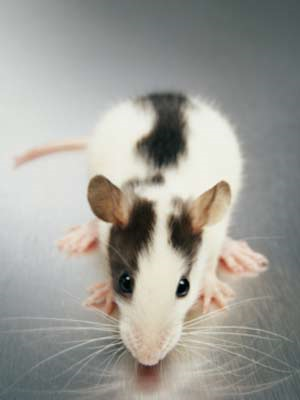Laboratory Animal Allergies
IntroductionAllergic reactions to animals are among the most common conditions affecting the health of workers involved in the care and use of research animals. An estimated 10 to 40% or all personnel who work with animal will develop allergies to animals. Notable sources of allergens from laboratory animals are from the proteins found in or on hair, dander, urine, saliva, and serum. These proteins are sufficiently foreign to the human immune system leading to potential immune reactions. It is therefore of great importance that personnel who work with laboratory animals understand the symptoms , the routes of exposure, the risk factors, and the preventative measures to be taken as they relate to laboratory animal allergy (LAA). |
 |
Symptoms
|
Allergic individuals may display any of a number of symptoms; allergic rhinitis (a condition characterized by runny nose and sneezing similar to hay fever); by allergic conjunctivitis (irritation and tearing of the eyes); by asthma (characterized by wheezing and shortness of breath), or by contact dermatitis (a red, bumpy rash that may appear where your skin touches the animal). If you have a stuffy nose or other respiratory signs, and if it seems to last longer than a common cold (weeks instead of days) then you may very well be suffering from an allergy |
Routes of ExposurePersonnel may be exposed to animal allergens through inhalation, and contact between skin, eyes, and mucous membranes with materials from the animal. These materials include animal bedding, animal hair, animal urine, animal saliva and animal serum. In addition, direct contact between skin and the animal may produce an allergic response. |
Risk FactorsRisk factors for developing laboratory animal allergies include history of previous allergies to animals and other environmental materials. A history of previous allergies (i.e., atopy) is not a guarantee that animal-related problems will develop, but some studies have found a correlation between pre-existing atopy and LAA. |
Preventative MeasuresLaboratory Animal Allergies can often be managed by a combination of medical management and work place strategies. It's important to consult with a physician to determine the cause of your allergy in order to manage it effectively. The most effective way to control and prevent allergies is to minimize exposure to the allergens. If you work in an animal facility, or if you work with animals in a laboratory setting, the following practices may help reduce your exposure to animal allergens:
If your job requires you to be exposed to something to which you are allergic, you should discuss with your physician what effect the allergy may have on your future health. Some workers are so severely affected that only a change in career will control their allergies. |
|
